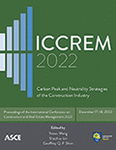Quantitative Assessment of the Sulphoaluminate Cement Embodied Carbon Emissions
Publication: ICCREM 2022
ABSTRACT
Cement industry is one of the most carbon emissions intensive sectors with 8%–9% of global carbon emissions. The sulphoaluminate cement is the hydraulic cementitious material with many excellent properties, and there is less limestone and the lower calcinate temperature than the Portland cement, but the GHG emissions has been not quantitative studied of the whole process. The carbon emissions of the embodied phase of Chinese sulphoaluminate cement were calculated and analyzed by the method of life cycle assessment. The results would provide reference for cement companies and industries to make the strategy and tactics of “carbon emissions reduction and carbon peak.”
Get full access to this article
View all available purchase options and get full access to this chapter.
REFERENCES
Chen, M. F. (2005). Life Cycle Assessment of Sulfoaluminate Cement. Beijing University of Technology, Beijing, China, 12–56. (in Chinese).
Chukwumerije, O., and Kristina, K. (2013). “Climate policy and business climate strategies: EU cement companies’ response to climate change and barriers against action.” Management of Environmental Quality: An International Journal, 24(3), 286–310.
Deja, J., Uliasz-Bochenczyk, A., and Mokrzycki, E. (2010). “CO2 emissions from Polish cement industry.” International Journal of Greenhouse Gas Control, 4(4), 583–588.
Di, X. H. (2005). Research on Some Basic Problems in Life Cycle Analysis of Resources and Materials. Beijing University of Technology, Beijing, China, 17–126. (in Chinese).
Glasser, F. P., and Zhang, L. (2001). “High-performance cement matrices based on calcium sulfoaluminate–belite compositions.” Cement and Concrete Research, 31(12), 1881–1886.
Hanein, T., Galvez-Martos, J. L., and Bannerman, M. N. (2018). “Carbon footprint of calcium sulfoaluminate clinker production.” Journal of Cleaner Production, 172, 2278–2287.
Hendrik, G. V. O., and Amy, C. P. (2002). “Cement manufacture and the environment: part I: Chemistry and technology.” Journal of Industrial Ecology, 6(1), 89–105.
Huntzinger, D. N., and Eatmon, T. D. (2009). “A life-cycle assessment of Portland cement manufacturing: Comparing the traditional process with alternative technologies.” Journal of Cleaner Production, 17(7), 668–675.
Jeon, E. D., Lee, K. U., and Lee, C. K. (2019). “Development of a new clean development mechanism methodology for the quantification of greenhouse gas in calcium sulfoaluminate cement.” Sustainability, 11(5), 1482.
Josa, A., Aguado, A., Cardim, A., and Byars, E. (2007). “Comparative analysis of the life cycle impact assessment of available cement inventories in the EU.” Cement and Concrete Research, 37(5), 781–788.
Rogelj, J., Elzen, M. D., Hohne, N., Fransen, T., Fekete, H., Winkler, H., Chaeffer, R. S., Ha, F., Riahi, K., and Meinshausen, M. (2016). “Paris Agreement climate proposals need a boost to keep warming well below 2 degrees C.” Nature, 534(7609), 631–639.
Stafford, F. N., Dias, A. C., Arroja, L., Labrincha, J. A., and Hotza, D. (2016). “Life cycle assessment of the production of Portland cement: A Southern Europe case study.” Journal of Cleaner Production, 126, 159–165.
Suh, S., Lenzen, M., Treloar, G. J., Hondo, H., Horvath, A., Huppes, G., Jolliet, O., Klann, U., Krewitt, W., Moriguchi, Y., Munksgaard, J., and Norris, G. (2004). “System boundary selection in life-cycle inventories using hybrid approaches.” Environmental Science & Technology, 38(3), 657–664.
Wang, Y. M., Su, M. Z., and Zhang, L. (1999). Sulfoaluminate Cement. Beijing University of Technology Press, Beijing. (in Chinese).
Xu, X. N. (2013). Life Cycle Assessment of Cement in China. Dalian University of Technology, Liaoning, China, 8–57. (in Chinese).
Information & Authors
Information
Published In
History
Published online: Dec 15, 2022
Authors
Metrics & Citations
Metrics
Citations
Download citation
If you have the appropriate software installed, you can download article citation data to the citation manager of your choice. Simply select your manager software from the list below and click Download.
